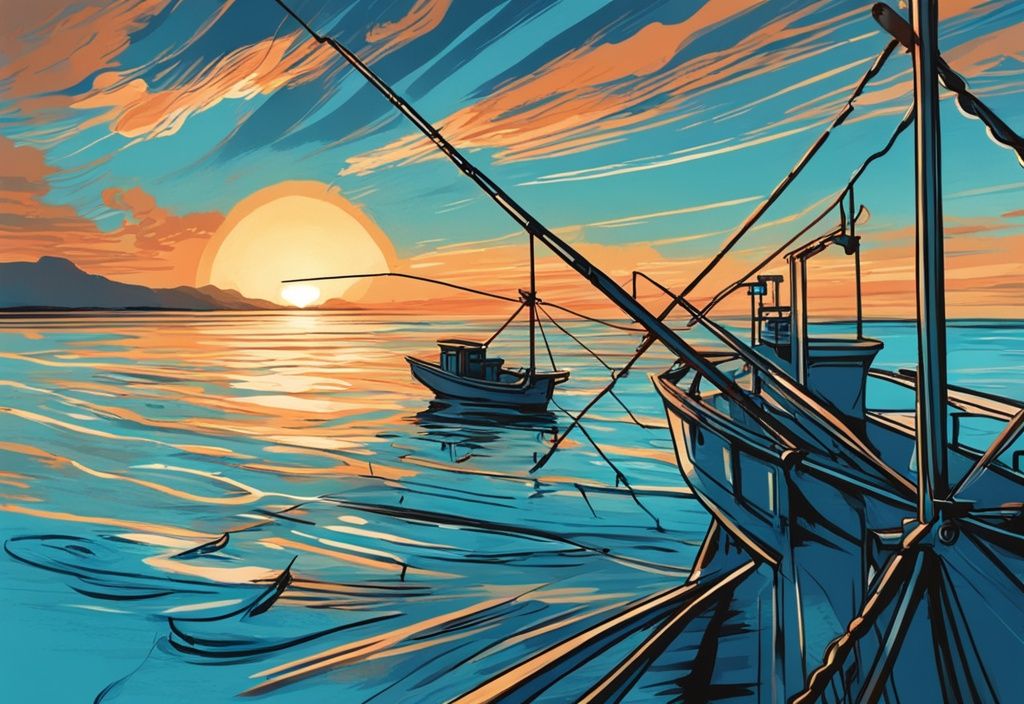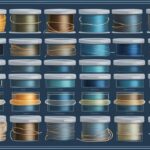What if I told you, folks, that the most thrilling fishing adventure you could ever ask for is about to begin? That’s right, it’s tuna fishing season! Now, don’t tell me that the thought of reeling in gigantic Tuna – Bluefin, Yellowfin, Albacore, hasn’t got your heart racing.
The sea can be a tricky mistress, always changing her moods with weather patterns and regional oddities. And let’s not underestimate the importance of having the right gear and the know-how to use it. But worry not – you’ve got Jake Marlin as your guide!
This article, my friends, is your ticket to an unforgettable big game hunt in the ocean! Let’s engage in some mind-and-muscle sport, respect our grand oceans, and reel in the big one, shall we?
A Brief Introduction to Tuna Fishing
Tuna fishing is a cornerstone of the angling world, blending excitement and deft skill into an unforgettable experience. Many anglers, myself included, are drawn to the sport by the exhilarating challenge tuna present. These fish are known for their fierce fights and monumental sizes, turning each catch into an adrenaline-pumping event. It’s not just about the thrill, though; fishing for tuna also means encountering a varied array of species, each boasting unique traits and behaviors.
Tuna species significantly differ in size and weight, offering diverse experiences. Imagine the thrill of landing a tuna that tips the scales at an astonishing 1,496 pounds! It’s encounters like these that add unpredictability and keep the hearts of anglers racing with anticipation.
In the U.S., certain tuna species are particularly popular. The Albacore, with its long pectoral fins, is a favorite. Then, there’s the robust Bigeye, often hanging out in deeper waters, and the Blackfin, renowned for its exceptional taste. But let’s not forget the Bluefin—this behemoth is not just massive but also prized for its culinary value.
Smaller species, such as Bonito, present their own set of challenges and are great for those who enjoy light tackle fishing. Longtail, Skipjack, and Yellowfin also add their unique flair—Skipjack, for instance, is more prevalent during warmer months, while Yellowfin is noted for its aggressive strikes and remarkable stamina.
Tuna fishing embodies a perfect mix of challenge, excitement, and diversity, making it an all-time favorite among many anglers. If you’re interested in exploring different fishing techniques, you might want to learn about jetty fishing, which offers its own set of challenges and rewards. The variety of tuna species ensures there’s always something new to learn and experience, keeping the adventure alive season after season. Whether you’re a seasoned angler or a curious newbie, the world of tuna fishing has something incredible to offer every time you cast your line.
Key Factors Influencing Tuna Fishing Seasons
Ich könnt’ euch stundenlang Geschichten erzählen über die Tuna Fishing Seasons und die Tücken, die damit einhergehen. Dieser Artikel gibt euch einen Überblick über die wichtigsten Faktoren, die diese Jahreszeiten beeinflussen und euch wertvolle Tipps für eure nächste Angelreise.
Popular Tuna Species and Their Peak Seasons
Wenn du schon mal auf Bluefin Tuna geangelt hast, dann weißt du, dass sie ihre besten Zeiten von Spätsommer bis Spätherbst haben. Während dieser Monate kannst du die wahre Kraft dieser majestätischen Kreaturen erleben. Stell dir vor, wie die warme Sonne deine Haut wärmt, während du gegen einen soliden Bluefin kämpfst. Da lacht doch das Anglerherz, oder nicht?
Yellowfin Tuna suchen ihr Glück auch im Sommer und Herbst – was für eine großartige Zeit, um deinem sportlichen Ehrgeiz freien Lauf zu lassen! Der Biss dieser schnellen, kraftvollen Fische ist unvergleichlich und bietet einen unvergesslichen Nervenkitzel.
Für diejenigen, die es lieben, ihre Angelzeit zu maximieren, sind Albacore Tuna die perfekten Begleiter, denn ihre Saison erstreckt sich von Frühsommer bis Spätherbst. Stellt euch die langen, sonnigen Tage vor, an denen ihr diese schnellen Schwimmer verfolgt – fast wie ein nie enden wollender Angeltraum.
Und dann haben wir noch Bigeye Tuna, die das ganze Jahr über wunderbare Möglichkeiten bieten. In den wärmeren Monaten erreicht ihre Aktivität ihren Höhepunkt. Und glaubt mir, das ist eine Vielseitigkeit, von der wir nur träumen können! Skipjack Tuna lieben ebenfalls die warmen Monate, und je nach Region kannst du viele verschiedene Orte erkunden, um sie zu fangen.
Impact of Weather Patterns Like El Niño
Wetterphänomene wie El Niño können dein Angelerlebnis völlig verändern. Diese Ereignisse bringen wärmere Meerestemperaturen mit sich und verschieben die Migrationsmuster der Tuna. Stell dir vor, wie Yellowfin und Bluefin während eines El Niño-Jahres dichter an die Küste ziehen. Das ist doch nahezu ein Paradies für jeden Angler, oder?
Diese warmen Gewässer sorgen auch für mehr Plankton, was die Nahrungsquellen für die Tuna erhöht und somit optimale Angelbedingungen schafft. Die durch El Niño getriebenen Meeresströmungen beeinflussen ebenfalls die Verteilung der Tuna. Die daraus resultierenden Bedingungen können außergewöhnlich sein, was bedeutet, dass große Tuna-Schulen häufiger anzutreffen sind.
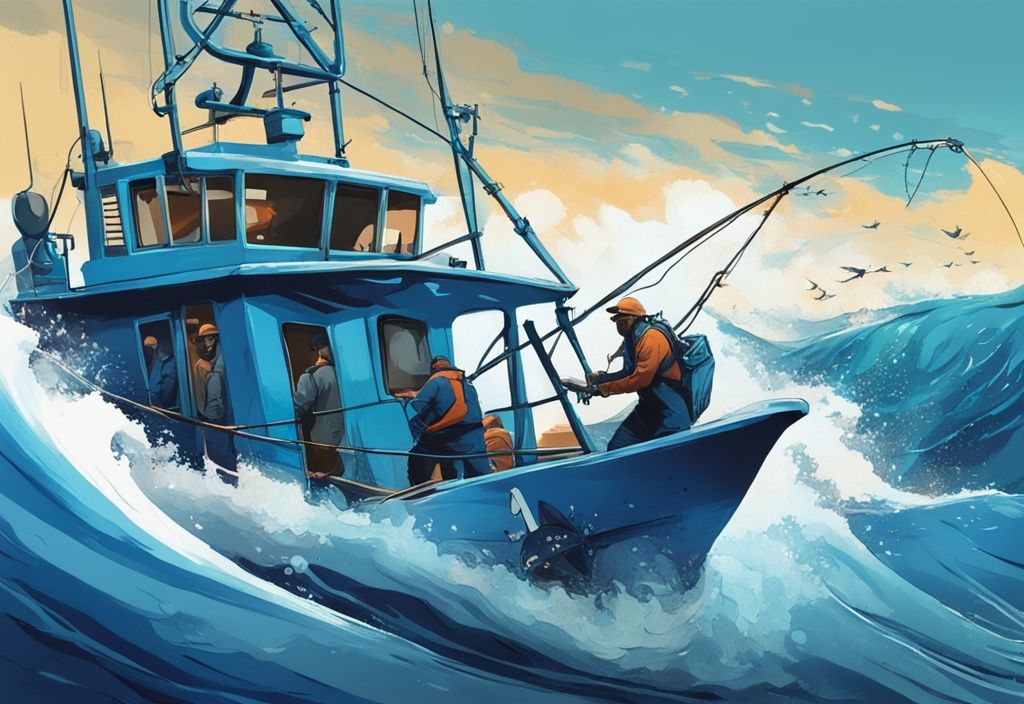
Wenn du die Wetterphänomene wie El Niño im Blick behältst, kannst du deine Angelreisen besser planen und die besten Zeiten und Orte finden, um deinen Ideal-Tuna zu fangen. Es geht darum, die Natur zu respektieren und zu nutzen, um das Beste aus jeder Saison herauszuholen.
All You Need to Know About Tuna Fishing Seasons by U.S. Region
Florida
The tuna fishing season in Florida spans from May to September, coinciding with the migration patterns of Yellowfin Tuna, the peak species in the region. These months offer prime conditions for anglers seeking the thrill of catching this powerful fish. However, it’s essential to note that the fishing conditions can be significantly affected by hurricanes. These weather phenomena can disrupt the season, making it imperative for fishing enthusiasts to monitor weather forecasts and plan their trips accordingly.
Hawaii
In Hawaii, the tuna fishing season also runs from May to September, with the peak fishing occurring between June and August. Yellowfin Tuna dominate these waters during the summer, providing ample opportunities for a successful catch. The warm tropical waters and consistent weather make Hawaii an ideal destination for tuna fishing during these months. Planning trips around these peak months can maximize your chances of landing this prized fish.
California
California’s tuna fishing season varies yearly, largely due to the dynamic ocean conditions along the Pacific Coast. The state is notable for hosting both Pacific Bluefin and Yellowfin Tunas, with the peak season extending from June to November. This timeframe offers a broad window for anglers to engage in the sport, with different periods favoring different species.
The best time to Fish for Pacific Bluefin Tuna
The best time to fish for Pacific Bluefin Tuna in California is from June 1 to November 1. During these months, the waters around San Diego, often hailed as the “Tuna Capital of the World,” are particularly abundant. These peak months provide not only the best opportunities for catching Bluefin Tuna but also the chance to experience one of the top tuna fishing destinations globally. For those willing to venture further south, year-round opportunities exist, making it possible to find tuna even outside the peak times.
Go Fully Prepared: Essential Gear for Tuna Fishing Season
The tuna fishing season demands that you have the right gear to tackle these powerful creatures. A well-chosen rod and reel can make all the difference in your success. Opt for a heavy-duty rod that has both flexibility and resilience—essential qualities when you’re up against the sheer strength of tuna. Pair it with a high-capacity reel to ensure you have enough line to handle prolonged battles.
Must-have Rods, Reels, Lines, Lures, and Baits
Now, let’s talk fishing lines. Durability and strength are non-negotiable. You’ll want a braided line for its minimal stretch, giving you better sensitivity to detect those subtle bites. Fluorocarbon leaders are a must as well; their invisibility underwater is crucial, especially in clear waters.
Lures and baits, oh boy, this is where your creativity needs to shine. Live baits like mackerel and sardines are absolute tuna magnets. But don’t overlook trolling lures like cedar plugs and spreader bars; their realistic movements can draw tuna in from afar. And if you’re into vertical jigging, jigs can be incredibly effective, especially when targeting tuna lounging in deeper waters.
Getting Started with Tracking Tools for Better Results
Tech tools can be your best friends during the tuna fishing season. The Fishbox App, for example, offers real-time tracking of weather and ocean conditions, allowing you to plan your trips when it’s prime time for tuna.
Don’t forget about GPS devices and fish finders. These gadgets not only help you locate schools of tuna with pin-point accuracy but also allow you to mark those honey-hole spots for future adventures. GPS and fish finders combined provide real-time data on fish depth and location, making your outings far more efficient and successful.
Equipped with the best gear and advanced tracking tools, you’re setting yourself up for a thrilling and successful tuna fishing season. So, get out there, feel the sun on your back, and enjoy the tug on your line—there’s nothing quite like it.
Tricks of the Trade: Techniques for Successful Tuna Fishing
Tuna fishing season is an exciting time for anglers, offering ample opportunities to test various techniques and gear. In the following sections, you’ll dive into effective methods to increase your chances of a bountiful catch during this prime fishing period.
Mastering the Art of Trolling with Lures
Trolling with lures is an invaluable technique during the prime tuna fishing season, particularly in spring and fall. This method involves dragging artificial lures through the water at various depths and speeds to mimic the movement and behavior of prey. Using brightly colored lures can attract the attention of tuna, which are often hunting near the water’s surface during these times. The bait’s movement, which can be altered by the trolling speed and type of lure, is crucial in mimicking the erratic behavior of live bait, enticing tuna to strike.
Invest in high-quality trolling rigs and ensure your boat’s speed aligns with the requirements of your chosen lures; this includes varying speeds for optimal lure action. Swivel connections could also reduce line twists, enhancing the realism of the presentation.
Remember, patience is key, as trolling covers large water areas, increasing the chance of encountering fish during the tuna fishing season.
Fishing under Moonlight: The Effect of Lunar Phases
The moon phases play a significant role in the tuna fishing season, particularly around the new moon. Tuna are more active during these lunar periods due to the influence of moonlight on their feeding behaviors. The new moon creates darker nights, which can increase tuna’s predator instincts, leading to more aggressive feeding.
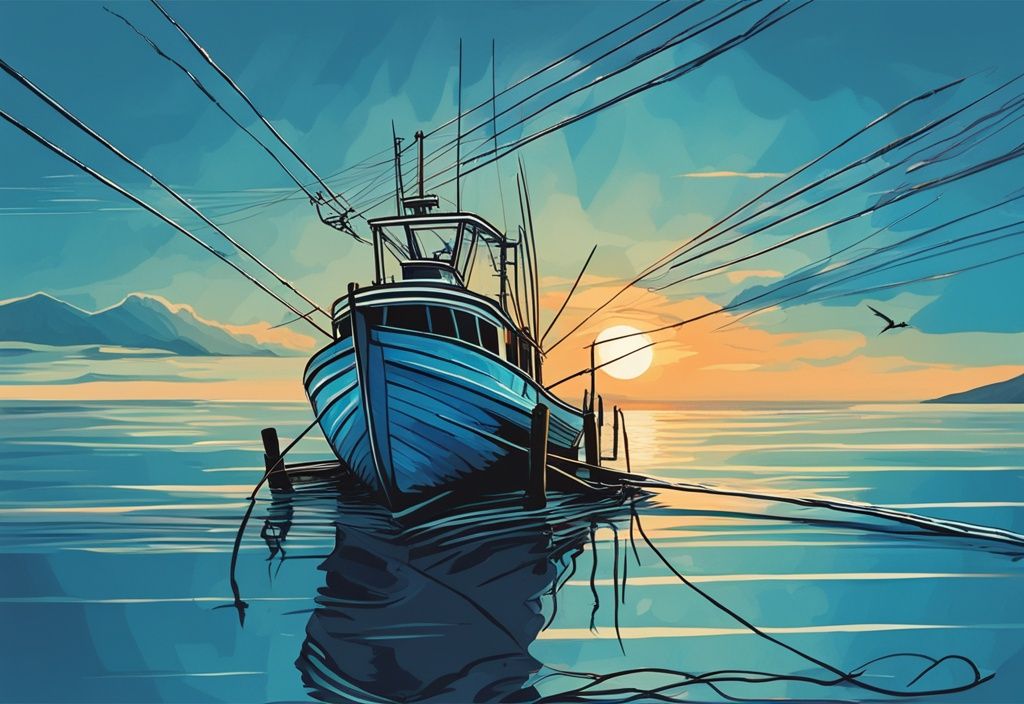
Planning your trips around the new moon can result in higher catch rates. Observing the lunar calendar and aligning your fishing with the peak activity periods enhances the likelihood of success.
Additionally, night fishing requires specialized gear, such as glow-in-the-dark lures and strong lights to attract plankton and small fish, thereby luring in tuna. Understanding these lunar influences can drastically improve your catch, transforming ordinary outings into highly productive fishing sessions during the tuna fishing season.
Navigating Regulations and Leading Conservation Efforts
Understanding the regulations governing the tuna fishing season is crucial for both recreational and commercial anglers. These regulations are not static; they vary from state to state and are influenced heavily by federal guidelines designed to preserve the sustainability of tuna populations.
A Rundown on State and Federal Regulations
Alright, let’s dive into the nitty-gritty. The National Oceanic and Atmospheric Administration (NOAA) Fisheries is the big cheese when it comes to outlining these guidelines, especially for the Atlantic bluefin tuna fishing season. Picture this: restricted-fishing days, carefully orchestrated based on detailed research on tuna migration patterns, spawning rates, and population health. These rules ensure we don’t fish tuna into oblivion, making sure the joy of angling can be passed down to the next generation.
From state to state, you’ll find these regulations dancing to different beats, all influenced by NOAA’s federal guidelines. It’s like a waltz towards sustainability, one move at a time. Tune in (pun intended) to these guidelines, and you’ll find yourself on the right side of both the law and conservation efforts.
Understanding Bag and Catch Limits
Bag and catch limits are another critical piece of the tuna fishing season puzzle. Ever wonder why these limits exist? They specify the maximum number of tuna that you can catch and keep within a given timeframe. Think of it as nature’s way of saying, “Leave some for the next guy!” These limits differ significantly across various states and countries, reflecting local conservation needs and fishing pressures.
Setting these limits is like having a safety net for our tuna friends. Overfishing can wreak havoc, leading to long-term declines and potential species collapse. So, following these rules isn’t just about obeying laws; it’s about ensuring that future generations can share the thrill and challenge of tuna fishing. Monitoring agencies frequently update these limits based on ongoing research, adapting to ensure sustainability. It’s a balancing act, but one worth mastering if we want to keep our lines tight and our hearts full.
The Finest Tuna Fishing Spots Around The World
Venturing to Australia
Australia is a renowned destination for tuna fishing, particularly known for its dynamic game fishing opportunities. The tuna fishing season in Australia spans from December to Easter, a period when the waters are teeming with activity. Among the various species, the Southern Bluefin Tuna stands out due to its notable size and the exhilarating challenge it offers to anglers. The Southern Ocean off the coast of Australia provides an ideal habitat for these majestic creatures, making it a prime location for experienced and adventurous fishermen looking to test their skills.
Areas such as Port Lincoln in South Australia are hotspots for Southern Bluefin Tuna, attracting numerous fishing enthusiasts every year. The rich marine biodiversity and the structured conservation efforts ensure that the tuna populations remain healthy and abundant during the peak season. The excitement of reeling in a large Southern Bluefin Tuna makes Australia a top choice for game fishing.
Experiencing Fishing in The Bahamas
The Bahamas is a sought-after destination for tuna enthusiasts, particularly during the tuna fishing season from May to August. During these months, the warm Caribbean waters around the islands become a hotspot for Yellowfin Tuna, known for their speed, agility, and delicious taste. The Bahamas offers a unique combination of stunning natural beauty and rich fishing grounds, making it a fisherman’s paradise.
The islands provide ample opportunities for both inshore and offshore fishing, with Yellowfin Tuna being one of the prized catches. Locations such as Nassau, Bimini, and Exuma are particularly popular, offering charter services that cater to both novice and experienced fishermen. The Yellowfin Tuna migration through the Bahamian waters ensures high chances of successful fishing trips, contributing to its reputation as a top fishing destination.
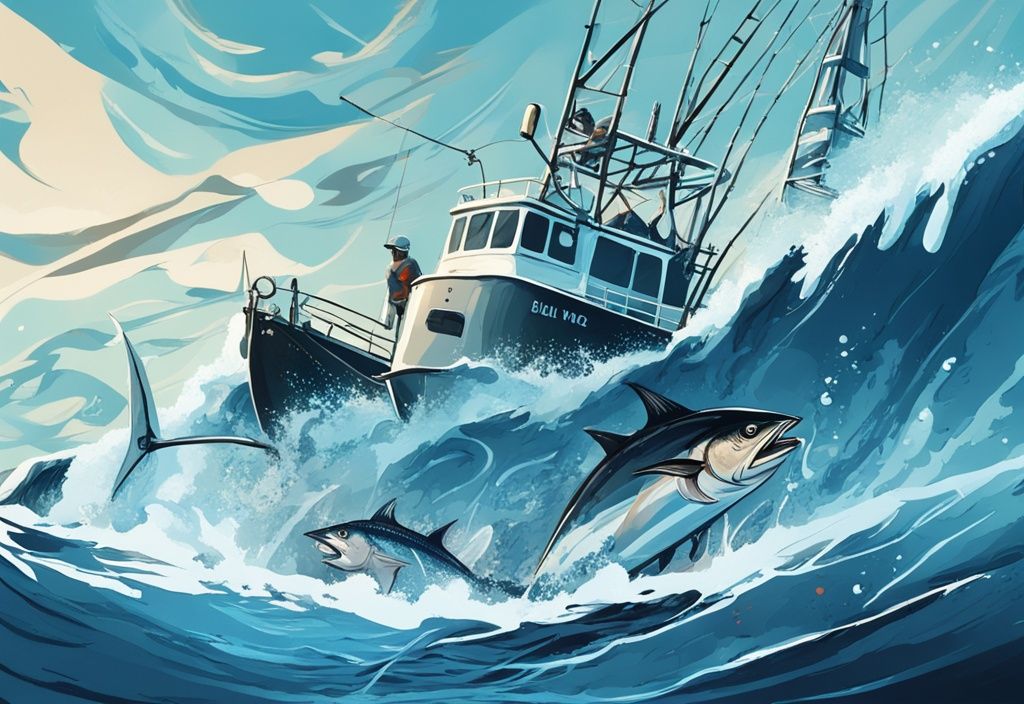
Moreover, the Bahamas is not just about fishing; the azure waters, vibrant coral reefs, and welcoming local culture enhance the overall experience. Whether you’re aiming to catch the formidable Yellowfin Tuna or simply enjoy a day out on the water, the Bahamas provides an unforgettable tuna fishing season experience.
Your Most Common Questions About Tuna Fishing Season Answered
The optimal time for Bluefin Tuna Fishing
The optimal time for catching Bluefin Tuna stretches from late summer through late fall. During these months, the waters teem with migrating Bluefin, offering prime fishing opportunities. These powerful fish, known for their tough battles and delectable taste, are a prized catch among anglers. Picture the sun setting over a vast ocean, the anticipation in the air, and the thrill of a Bluefin’s powerful tug on your line. That’s what makes this season unforgettable.
Your guide to choosing the right gear for tuna fishing
Choosing the right gear for tuna fishing season can make or break your trip. Imagine wrestling with a giant Bluefin; you need a heavy-duty rod and reel with high line capacity to match their sheer power. A robust fishing line is non-negotiable; after all, you don’t want it snapping under the strain of an energetic tuna diving deep. Equip yourself with a variety of lures and baits – live baits, trolling lures, and jigs – to attract different tuna species. Remember, preparation is half the battle. A well-chosen arsenal of gear could spell the difference between a good fishing story and a legendary one.
Understanding the enforcement of Tuna Fishing regulations in the U.S.
Enforcement of tuna fishing regulations in the U.S. is managed by state and federal agencies, making it a crucial aspect to understand before casting your line. Regulations are designed to ensure sustainable fishing and conservation, including size and bag limits, and designated fishing days. The National Oceanic and Atmospheric Administration (NOAA) sets forth specific guidelines for the Atlantic Bluefin Tuna fishing season. Staying informed and compliant with these rules isn’t just good practice; it helps preserve tuna populations for future generations. Always check the local regulations to ensure you’re following the right guidelines on your adventure.
A Journey Credits Sustainable Practices: Wrapping Up
The significance of sustainable fishing practices cannot be overstated. In the context of the tuna fishing season, adherence to sustainable methods ensures that the thrill of tuna fishing can be enjoyed for generations to come. This involves making conscious decisions about when, where, and how we fish for tuna.
First and foremost, anglers must abide by season dates. Tuna fishing seasons are established based on extensive research into tuna population dynamics, migration patterns, and spawning cycles. By respecting these dates, fishermen help protect tuna during critical reproductive periods, thereby supporting the regeneration of healthy stocks.
Size limits are another crucial element of sustainable tuna fishing. These regulations are designed to ensure that juvenile tuna, which have not yet had the opportunity to reproduce, are released back into the ocean. This measure helps maintain robust tuna populations by allowing more fish to reach maturity and contribute to the gene pool.
Additionally, following catch limits is essential. These limits control the number of tuna that can be harvested, preventing overfishing and depletion of the species. Overfishing leads to reduced tuna populations, which can have cascading effects on the marine ecosystem and the overall health of the ocean.
Lastly, collective conservation efforts are vital in sustaining healthy tuna stocks. Participating in programs and supporting organizations dedicated to tuna conservation can amplify the impact of individual actions. Awareness campaigns, funding research, and advocating for sustainable policies are steps that can make a considerable difference.
By adopting these sustainable practices during the tuna fishing season, anglers contribute to the long-term health and viability of tuna populations. This ensures that the sport of tuna fishing can continue to be a cherished tradition, offering the thrill of the catch while preserving the species for future enthusiasts.
